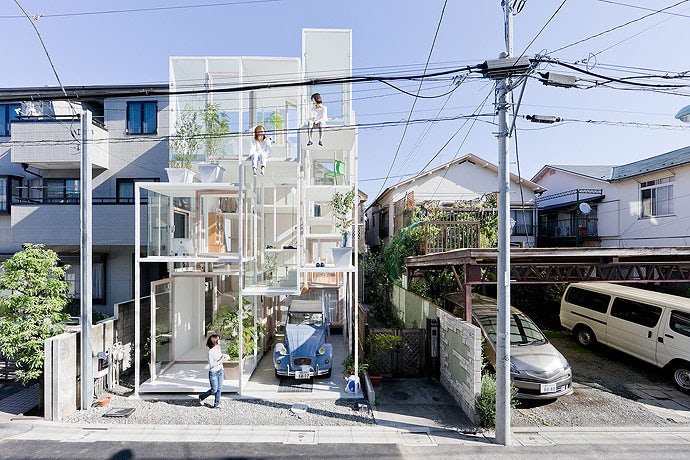From questionable projections, to houses built without visible windows, to fantasy-life forms, Japanese residential architecture often pushes the boundaries of what we typically define as a “home.” We’re not talking about just a few examples of unusual housing designs—there is a domestic gusto sweeping the country that champions the eccentric and eschews the traditional as a form of personal expression and creativity. When viewing Japan’s single family homes on the Architizer database, it’s easy to emit expressions of bewilderment.
The persistent tendency for home owners in Japan to opt for radical houses would suggest a booming economy that has allowed couples to invest in their home’s façade — especially when Japan has the highest number of architects per capita in the world. However, most of these peculiar residences are built by younger, middle-class couples without a huge budget. This inclination seems to overlook the fact that Japan faces high rates of housing vacancies with little demand to renovate old homes. Not to mention, Japan’s economy has been famously sluggish since the late 1980s, which makes the idea of building a new house seem rather inadvisable.

© Shinichi Ogawa & Associates
Cube Court House by Shinichi Ogawa & Associates

© Torafu Architects
House in Kohokuby Torafu Architects
So what then, has brought on this obsession for newer, more avant-garde housing designs? Why in a slumping economy are home-owners in Japan so willing to invest in an unusual design without knowing its staying power? Perhaps these questions require a more complex answer.
In the Freakonomics podcast “Why Are Japanese Homes Disposable?”, Tokyo architect Alastair Townsend traces this phenomenon to the fact that houses in Japan depreciate in value exponentially faster than those in America, Great Britain and other parts of Asia. In fact, Japanese houses lose all of their value after just 30 years, while half are expected to be demolished after 38 years. This startling fact essentially renders the future of these residences literally disposable, making home-owners more willing to take risks in design.

© Nobuo Araki/The Archetype
House in Mishuku ⅡbyNobuo Araki/The Archtype
However, the situation is a little more complex than that.
For one, Townsend highlights fundamental cultural differences between how houses are valued both in Japan and in countries like the United States and Great Britain. Quite simply, there is little demand for older homes. Whereas in Western countries, older structures like brownstones and Victorian homes have appreciated in value over time due to charm, sentiment and appreciation for historical architecture, Japanese people appear more comfortable with letting go of aging buildings.

© Atelier TEKUTO
But this comfort has a deeper connection with the Japan’s frequent need to rebuild its housing sectors. When the atomic bombs were dropped on Hiroshima and Nagaski during World War II, the cities were essentially wiped out, and Japan had to quickly construct houses to shelter the survivors of the catastrophe.
The vast majority of residences built after World War II were constructed rather hastily, with cheaper building materials and less strict building codes. The frequency of earthquakes and natural disasters have also challenged the permanence of residences in the country, too.

© Sou Fujimoto Architects
House NA by Sou Fujimoto Architects
Currently, the vast majority of Japan’s existing houses were built in the mid-1980s, as many of the post World War II homes were quickly viewed as unsafe and disposable. But even these better-quality homes built to comply with new earthquake codes will likely fall to the wayside.
Older homes in Japan simply do not retain their value because nostalgic sentiment is not present. It’s a fact that many Japanese home-owners know too well, and it has led to wildly unorthodox structures born out of their ephemerality — a sort of experimental swan song to their eventual demise.

© Atelier TEKUTO
Still, while these unique circumstances in Japan have helped create some of the most idiosyncratic houses on the planet, there is an inherent wastefulness in the practice of tearing down and rebuilding that might even be contributing to Japan’s economic slump.
According to Richard Koo, an economist in Tokyo, the continuous cycle prevents families from building wealth on top of wealth, often selling their homes for less than they paid, preventing what he calls the construction of an “affluent society.”




